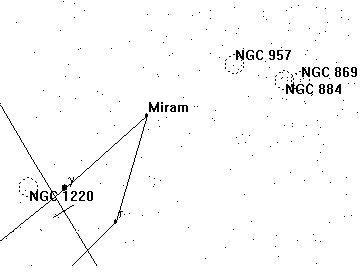An Anonymous Dark Nebula
Jack Kramer
We tend to think of dark nebulae (or "coal sacks") as objects found in the heart of the summer Milky Way. Yet there are dark nebulae in many other parts of the sky, as well. One such very challenging object lies in Perseus - a constellation well placed for fall and winter observing. This seems to be a huge slice of obscuring material that is not designated with a Barnard number, as are most dark nebulae. Interestingly, it doesn't carry any other designation either! It's also not shown on any star charts to which I have access. Checking the digitized POSS (Palomar Observatory Sky Survey), there was no clear indication of any obscuring matter in this area. But that could be due to the faintness of the background stars versus the limiting color/magnitude of the sky survey.
I heard of this dark swath through an Internet correspondent who cited Crossen and Tirion's observing guide Binocular Astronomy, page 48: "Just 3° east of the Double Cluster is the edge of the dark obscuring matter that covers most of Perseus. This boundary runs for about 4° on a NNW to SSE line, passing just west of Eta Persei (Miram), and is so abrupt that it can be seen with averted vision in 10x50 binoculars. With careful looking on a very dark night you might even be able to see, due west of Eta Persei and just outside the main body of the dark clouds, two long thin streaks of outlying obscuration. They look remarkably like long thin cirrus outliers..."

Armed with this information, I tried for this dark nebulosity with my 6-inch APO, using a 40mm Pentax XL eyepiece to provide as wide a field as possible. The site was at the downstate 2003 Illinois Dark Skies Star Party, which, as the name implies, does enjoy a very dark sky. I started at the Double Cluster (NGC 869 and 884) and scanned the area looking for telltale star-poor areas. But none could be identified. Then I located the star Miram and swept due west from there. I was just barely able to make out several widely-spaced narrow strips where there seemed to be fewer stars. But the contrast with the background star field was not pronounced.
Next I tried a 9x60 binocular, in which the dark streak showed up as a fairly large strip west of Miram that was somewhat star-poor compared to the surrounding area. Contrary to what Crossen and Tirion say in their book, it was visible by direct vision. (That may be due to the larger-sized binoculars than they used.) The fact that it's long and narrow helps in seeing it. I cannot say that I was able to detect the larger main body of this obscuring matter, even with the advantage of wide field binoculars.
This dark area is easier to see in binoculars than in a telescope. Comparing the two views, it seems as though this darker region might be made up of a number of star-poor tendrils that blend in binoculars to form the larger oblong patch. Assuming you're able to see this visually, there's still a fly in the ointment. Is this truly a mass of obscuring matter, or just a star-poor area of the sky? (That's why I used the words "seems to be" in the first paragraph.) Somehow I find it unlikely that it would be anonymous if it were truly a dark nebula. And since this dark area has no official designation, how would you refer to it in your observing notes? Perhaps you might call it the "Crossen and Tirion Dark Nebula" ... or try naming it after yourself. (Then it would be rescued from anonymity!)





